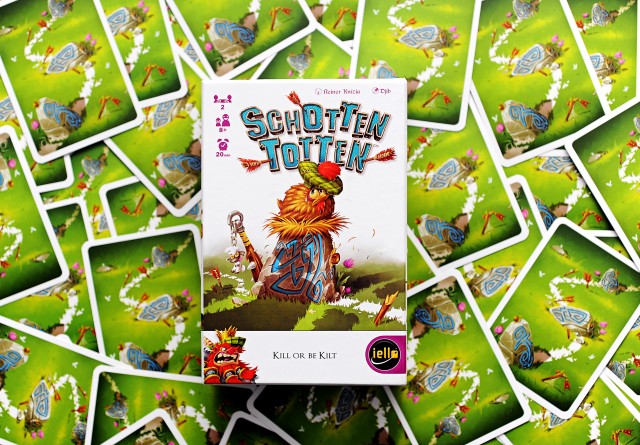Schotten Totten was first published way back in 1999. It’s a game about two warring Scottish clans fighting over territory. You more likely know the same game as Battle Line. Reiner Knizia took the mechanics of his original and reimagined them as one of the great historic wars between the Greeks and the Persians. While Battle Line certainly gained more notoriety, it can be hard to track down a copy. That’s why I was really happy to see that Iello was putting their beautiful production power behind a new version of Schotten Totten.
In Schotten Totten, two-players are leaders of their Scottish clans fighting over a line of nine stones that divides their territories. They will contest each different stone, with a battle that must be won to claim them. The clan leaders will go back and  forth deploying troops at the different stones one at a time, creating battle formations. The goal is to come up with the strongest formation at each stone to claim it, using Clan cards numbered 1-9 in six different suits. After three Clan members have been deployed on either side of a stone, players can assess who had the stronger formation, with the winner claiming the stone.
forth deploying troops at the different stones one at a time, creating battle formations. The goal is to come up with the strongest formation at each stone to claim it, using Clan cards numbered 1-9 in six different suits. After three Clan members have been deployed on either side of a stone, players can assess who had the stronger formation, with the winner claiming the stone.
The quality of the formation is based on a simplified poker model. Getting a run of three Clan members of the same colour, (4-5-6 of Blue for example), is the best formation you can assemble. Below that is a three-of-a-kind, then three cards of the same colour, followed by a run, and finally if both players have none of those hands, simply the sum of their assembled cards is valued against each other.
It definitely becomes a game of cat and mouse as one card at a time players begin to assemble their formations. You don’t want to commit too early, but when you have what you think is a good combination of Clan members it can behoove you to play them out. If you can prove that your formation can’t be beaten by your opponent, you can claim the stone for yourself. So, for example if you are able to create a run of 7-9 in the same suit (the best possible hand), at best your opponent could tie you, meaning you get to claim the stone for yourself. Just like Battle Line, Schotten Totten is a balancing act between committing to a plan or waiting out your rival.
The game ends if one player has been able to claim five of the nine stones or three adjacent stones. The very simple rules, belie the brilliant depth of strategy you’ll need to employ to come out successful in your quest for more Scottish land.
To spice things up like a delicious plate of Haggis, you can add in Tactic cards. These cards form a separate deck that you can draw from instead of the Clan cards. The Tactics are cards with special abilities that can shake up the rules of the normal game. For example the Shield Bearer is a card of 1, 2, or 3 value and a wild colour that you’ll choose when you place it down. The Blind-man’s Bluff forces you to only add the sum of the cards for the stone it’s placed on, ignoring any possible  combinations. The Traitor allows you to choose a card on an unclaimed stone on your opponent’s side of the border and place it on your side of the border on an unclaimed stone. Putting the Tactics cards in the game can turn it on its head and totally mess with a well-established strategy. You’re never sure what your opponent may have and how it’s going to screw up your plans.
combinations. The Traitor allows you to choose a card on an unclaimed stone on your opponent’s side of the border and place it on your side of the border on an unclaimed stone. Putting the Tactics cards in the game can turn it on its head and totally mess with a well-established strategy. You’re never sure what your opponent may have and how it’s going to screw up your plans.
Schotten Totten is a simple game in the components department. It’s basically he two different decks of cards and nine different stone tiles that form the border between the two clans. Even with that simple set-up, Iello does typically great job with the production. The art is fun and colourful and visually, the stone tiles make an easy to read border between the two warring sides.
If you have been trying to get your hands on a copy of Battle Line, or you’re just looking for a brilliant, strategic two-player game, Schotten Totten is a perfect fit. I’m so glad that Iello has brought back this Knizia classic.
[…] Schotten Totten image by Daily Worker Placement […]